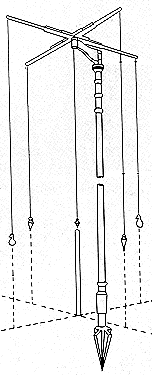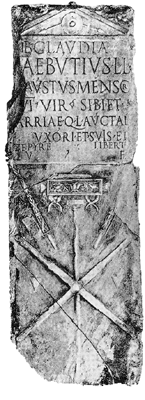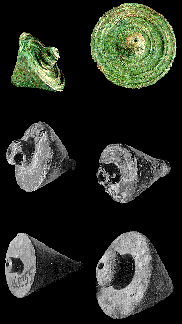|
 The groma was the principal surveying instrument of the Roman
agrimensores, the land surveyors. The instrument itself was simple
in design, crossed arms resting on a bracket and attached to a vertical
staff. The four arms each had a cord with a hanging plumb bob. It was
designed to survey straight lines and right angles. On the right is
a drawing of a replica of a groma now in the Science Museum, London.
The original metal parts were found in the Workshop of the surveyor
Verus at Pompeii, and are now in the Museo Nazionale, Naples. Click
on the plumb bobs or the pointed end of the staff to see photographs
of the original parts.
The groma was the principal surveying instrument of the Roman
agrimensores, the land surveyors. The instrument itself was simple
in design, crossed arms resting on a bracket and attached to a vertical
staff. The four arms each had a cord with a hanging plumb bob. It was
designed to survey straight lines and right angles. On the right is
a drawing of a replica of a groma now in the Science Museum, London.
The original metal parts were found in the Workshop of the surveyor
Verus at Pompeii, and are now in the Museo Nazionale, Naples. Click
on the plumb bobs or the pointed end of the staff to see photographs
of the original parts.
 We
are fortunate to have the tombstone of a Roman surveyor with a sculpted
relief, figure to the left, which depicts certain attributes of his
profession. It is the tombstone of Lucius Aebutius Faustus, of the first
century B.C. and is in the Museo Civico at Ivrea in Northern Italy. We
are fortunate to have the tombstone of a Roman surveyor with a sculpted
relief, figure to the left, which depicts certain attributes of his
profession. It is the tombstone of Lucius Aebutius Faustus, of the first
century B.C. and is in the Museo Civico at Ivrea in Northern Italy.
The stone relief has a Latin inscription which is translated as follows:
Lucius Aebutius Faustus, freedman
of Lucius Aebutius, of the tribe of Claudia, surveyor, sevir, erected
this monument while still alive for himself and his wife Aria Aucta
freedwoman of Quintus Arrius, and their children, and the freedwoman
Zepyra.
The component parts of the sculptural
relief are the following: In the
pediment are a shield and spears. Beneath the inscription is a dismantled
groma. Above this are the symbols of a sevir, two fasces and between
them a low seat.
Photo Credits:
- Museo Civico, Ivrea
- Museo Nazionale, Naples
- Science Museum, London
Bibliography:
-
O.A.W. Dilke, The Roman Land Surveyors,
New York, 1971
-
O.A.W. Dilke, "Roman Large-Scale Mapping
in the Early Empire," in The History of Cartography, Volume One,
Cartography in Prehistoric, Ancient and Medieval Europe and the
Mediterranean, J.B. Harley and David Woodward, eds., Chicago,
1987, pp. 212-223.
 The
Plumb-Bobs of a Groma The
Plumb-Bobs of a Groma
These plumb-bobs are examples of what
Roman carpenters, bricklayers, and surveyors used to trace vertical
lines and to determine horizontal planes. Plumb bobs are usually conical
and are either made of bronze or iron.
Descriptions from Top to Bottom:
- Left, H. 4 cm, Diam. 4.7 cm. Bronze
Right, H. 4.5 cm, Diam. 6 cm. Bronze
- Left, H. 2.7 cm, Diam. 2.5 cm. Bronze
Right, H. 3 cm, Diam. 2.2 cm. Bronze
- Left, H. 5.3 cm, Diam. 4.6 cm. Bronze
Right, H. 5 cm, Diam. 3.6 cm. Bronze
 Photo
Credits: Photo
Credits:
- Musei Capitolini, Rome, Italy
- Museo Nazionale, Rome, Italy
- Museo Nazionale, Rome, Italy
The Point of a
Groma
The point (to the right), usually made
of bronze, was placed on the end of a staff to secure the groma in its
position before surveying. It is possible that this example was used
either on a groma or on a measuring staff.
Descriptions:
Photo Credits:
- Museo Nazionale, Naples, Italy
|

